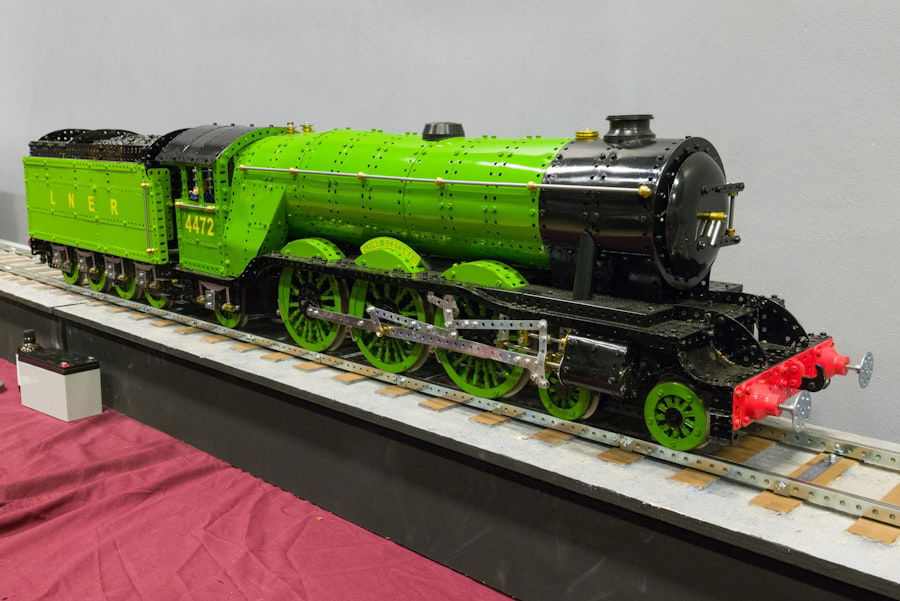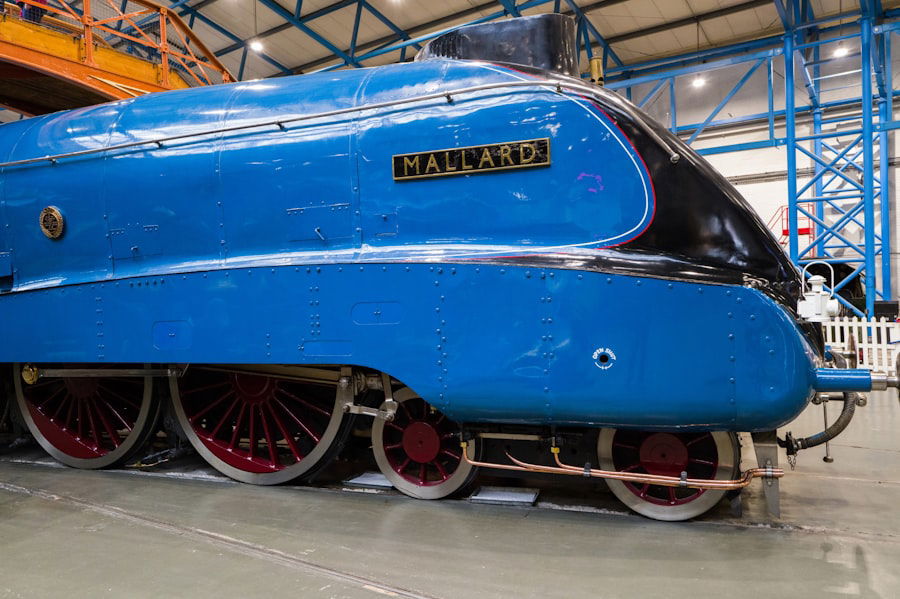Terence Cuneo was a prominent British artist renowned for his exceptional paintings of locomotives and railway scenes. Born in London in 1907, Cuneo grew up in an artistic family, which exposed him to the world of art from an early age. He received formal training at the Chelsea School of Art and the Slade School of Fine Art, where he developed his distinctive style and refined his techniques.
Initially, Cuneo worked as an illustrator for magazines and books. However, his passion for trains and railways ultimately defined his artistic career. His breakthrough came when he was commissioned to create a series of paintings for the London, Midland and Scottish Railway, which marked the beginning of his successful career as a locomotive painter.
Throughout his life, Cuneo produced an extensive portfolio of work, skillfully capturing the beauty and power of locomotives. His paintings are characterized by meticulous attention to detail, vivid colors, and dynamic compositions that effectively convey the grandeur of trains on canvas. Cuneo’s artistic legacy continues to inspire both art enthusiasts and train aficionados, solidifying his position as a leading figure in the genre of locomotive painting.
Key Takeaways
- Terence Cuneo was a renowned British artist known for his paintings of locomotives and railway scenes.
- The Golden Age of Locomotives, a period of rapid technological advancement and expansion in the railway industry, inspired Cuneo’s work.
- Cuneo’s unique style and technique, characterized by meticulous attention to detail and vibrant colors, set his locomotive paintings apart.
- Cuneo’s paintings captured the majesty and power of locomotives, showcasing their beauty and significance in the history of transportation.
- Cuneo’s locomotive paintings continue to captivate audiences with their timeless appeal, preserving the legacy of the artist in the art world.
The Golden Age of Locomotives
The Iconic Steam Engines
The golden age of locomotives was characterized by iconic steam engines such as the Flying Scotsman, the Mallard, and the Duchess of Hamilton, which captured the imagination of people around the world.
Locomotives and Transportation
Locomotives played a crucial role in transportation, connecting cities and towns and facilitating the movement of goods and people. The sight and sound of a steam locomotive chugging along the tracks became synonymous with progress and industrialization, making trains a symbol of modernity and power.
Inspiring Nostalgia and Romance
The golden age of locomotives also inspired a sense of nostalgia and romance, as people marveled at the engineering marvels that powered the railway revolution. It is within this rich historical context that Terence Cuneo found his muse, capturing the grandeur and allure of steam-powered trains in his iconic paintings.
Cuneo’s Unique Style and Technique

Terence Cuneo’s unique style and technique set him apart as a master of locomotive painting. His attention to detail and ability to capture the essence of a locomotive in motion made his work truly exceptional. Cuneo’s paintings often featured dramatic perspectives that showcased the sheer power and majesty of steam engines, with billowing smoke and steam adding to the sense of dynamism and energy.
His use of vibrant colors and meticulous brushwork brought his subjects to life, creating a sense of realism that resonated with viewers. Cuneo’s technique involved careful observation and study of his subjects, allowing him to accurately depict the intricate details of locomotives and railway scenes. His compositions often featured bustling railway stations, bustling with activity, adding depth and narrative to his paintings.
Cuneo’s ability to capture the atmosphere and ambiance of these settings made his work not only visually striking but also emotionally evocative. His dedication to his craft and his passion for trains shone through in every brushstroke, earning him a reputation as one of the most talented locomotive painters of his time.
Capturing the Majesty of Locomotives
| Locomotive Model | Top Speed (mph) | Weight (tons) | Length (ft) |
|---|---|---|---|
| EMD SD70ACe | 70 | 432 | 74 |
| GE ES44AC | 75 | 432 | 73 |
| EMD GP38-2 | 65 | 125 | 59 |
Terence Cuneo had a remarkable ability to capture the majesty of locomotives in his paintings, bringing these powerful machines to life on canvas. His depictions of steam engines in motion were particularly striking, as he expertly conveyed their strength and grace through his dynamic compositions. Cuneo’s paintings often featured trains thundering down the tracks, with billowing smoke and steam adding to the sense of drama and excitement.
His attention to detail was unparalleled, as he meticulously rendered every aspect of the locomotives, from their intricate machinery to their gleaming surfaces. Cuneo’s ability to convey the sheer power and scale of locomotives was truly remarkable, as he imbued his subjects with a sense of energy and vitality that leapt off the canvas. His use of perspective and composition added depth and movement to his paintings, creating a sense of immersion that transported viewers to the heart of the railway action.
Whether depicting a majestic steam engine in full throttle or a quiet moment in a bustling railway station, Cuneo’s paintings captured the essence of locomotives in all their glory, leaving an indelible impression on all who beheld them.
The Enduring Appeal of Cuneo’s Locomotive Paintings
The enduring appeal of Terence Cuneo’s locomotive paintings lies in their ability to evoke a sense of nostalgia, wonder, and admiration for the golden age of steam. His work resonates with both train enthusiasts and art lovers alike, as it captures a bygone era when locomotives reigned supreme as symbols of progress and power. Cuneo’s paintings transport viewers to a time when steam engines ruled the rails, evoking a sense of romance and adventure that continues to captivate audiences to this day.
Cuneo’s meticulous attention to detail and his ability to convey the atmosphere and ambiance of railway scenes make his paintings timeless works of art that transcend generations. His depictions of iconic locomotives such as the Flying Scotsman and the Mallard have become iconic symbols of an era when trains were at the forefront of technological innovation and industrial prowess. Cuneo’s legacy as a locomotive painter endures through the enduring appeal of his paintings, which continue to inspire awe and admiration for the beauty and grandeur of steam-powered trains.
Cuneo’s Legacy in the Art World

A Lasting Impact on the Art World
Cuneo’s paintings have been exhibited in prestigious galleries and museums around the world, where they continue to attract audiences with their timeless beauty and historical significance.
Inspiring a New Generation of Artists
Cuneo’s influence extends beyond his own paintings, as he inspired countless artists to explore the theme of locomotives in their own work. His unique style and technique have served as a source of inspiration for generations of painters, who have sought to capture the majesty and allure of trains in their own artistic endeavors.
A Timeless Legacy
Cuneo’s legacy lives on through these artists, who continue to pay homage to his groundbreaking contributions to the art world.
The Timeless Beauty of Cuneo’s Locomotive Paintings
The timeless beauty of Terence Cuneo’s locomotive paintings lies in their ability to transcend time and evoke a sense of wonder and admiration for the golden age of steam. His masterful depictions of steam engines in motion capture the essence of these powerful machines with unparalleled skill and artistry. Cuneo’s paintings transport viewers to a bygone era when trains were at the forefront of technological innovation, evoking a sense of nostalgia for a time when locomotives symbolized progress and industrial prowess.
Cuneo’s ability to convey the atmosphere and ambiance of railway scenes adds depth and narrative to his paintings, creating a sense of immersion that captivates audiences. Whether depicting bustling railway stations or majestic steam engines thundering down the tracks, Cuneo’s work captures the grandeur and allure of trains in all their glory. His paintings continue to inspire awe and admiration for the beauty and power of steam-powered locomotives, leaving an enduring legacy that resonates with art enthusiasts and train aficionados alike.
If you’re interested in learning more about financial strategies and risk management, you may want to check out this article on 5 Financial Hedging Strategies Worth Considering. Understanding how to hedge against financial risks can be crucial for businesses and individuals alike, and this article provides valuable insights into different hedging strategies. And if you’re looking for more business case studies, you can also explore the one on Nasdaq to learn about the company’s history and success.
FAQs
What are Terence Cuneo locomotive paintings?
Terence Cuneo locomotive paintings are a series of artworks created by the renowned British artist Terence Cuneo, featuring various locomotives and trains.
Who was Terence Cuneo?
Terence Cuneo (1907-1996) was a British painter famous for his depictions of railways, particularly locomotives and trains. He was also known for his military and industrial subjects.
What is the significance of Terence Cuneo locomotive paintings?
Terence Cuneo’s locomotive paintings are significant as they capture the beauty and power of steam and diesel locomotives, as well as the nostalgia of the golden age of railways. They are highly regarded by railway enthusiasts and art collectors.
Where can Terence Cuneo locomotive paintings be found?
Terence Cuneo locomotive paintings can be found in various art galleries, museums, and private collections around the world. They are also available for purchase through art dealers and auction houses.
What is the style of Terence Cuneo locomotive paintings?
Terence Cuneo’s locomotive paintings are characterized by their detailed and realistic portrayal of locomotives, often set against dramatic landscapes or industrial scenes. Cuneo’s use of light and shadow adds depth and dynamism to his compositions.
Are there any famous examples of Terence Cuneo locomotive paintings?
One of the most famous examples of Terence Cuneo’s locomotive paintings is “The Battle of the Coronel,” which depicts a historic naval battle during World War I. Cuneo’s depiction of the battle, including the sinking of British ships, is highly acclaimed for its accuracy and drama.
